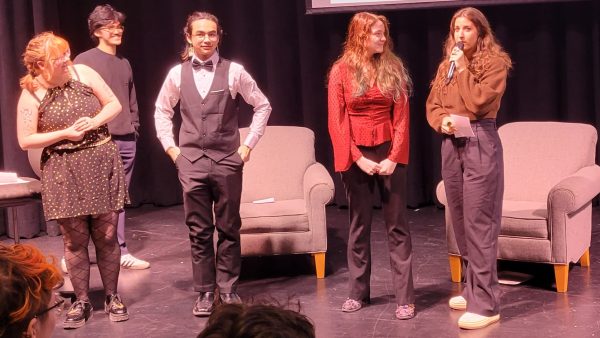Midmortems: What the Game Studio Students Have Been Working on This Semester

From 2354 by Stay Tuned Games
Every year, Champlain College’s senior Game Studio students work together to create video games using the skills they’ve developed over their time at Champlain. This is a year-long process that requires hundreds of hours of work from each student. However, not all the projects that are started make it to fruition at the end of the school year. At the end of the fall semester about half the games are cut, and those students are reassigned to other groups through a process called midmortem.
This year’s midmortem presentation is on November 19, and The Crossover has been meeting with various groups in the month leading up to it to see what everyone is working on.

Disco🕺Vision
Group Members: Jody Briggs, Artist; Mish Shea, Designer; Cyrus Burris, Producer; Kylie O’Keefe, Artist; Calum Phillips, Programmer
Game Name: Blood to Ink
About the Game: Blood to Ink is a narrative-based point and click or “tap and pinch” 1950s murder mystery game for tablets. The game is in grayscale with flashes of red for emphasis, and the backgrounds are 3-D with 2-D characters over top. You play as an author investigating a murder for a book, and to do so you can examine evidence, call people, and conduct interviews.
“You’re dealing with complex issues. It’s not just a happy-go-lucky story… It’s a serious story and it covers serious issues, and part of what we’re trying to do with that is we want to look at how these issues were looked at at the time,” Cyrus Burris said.

Fat Pigeon Studios
Group Members: Julia Wolniewicz, Lead Artist; Billy Beanland, Lead Designer; Travis Cunningham, Producer; Connor Breen, Programmer
Game Name: Change, Please!
About the Game: Change, Please! is a PC, puzzle platformer game where you play as coin navigating through the inside of a vending machine. You can change between coin types to solve puzzles, and different coins have different properties. For example, pennies can conduct electricity, and dollar coins can push larger objects.
“You think you know what happens when you put a coin in a machine. You know it goes five inches in a tray or whatever. But, what if there was a secret society or life or world?” Travis Cunningham said about where the idea for the game from.
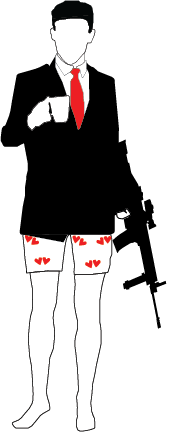
Serious Businessmen
Group Members: Brandon Schlossberg, Producer; Thomas Ray, Artist; Graham Pannier, Designer; Summer Softleigh, Programmer
Game Name: Falchion
About the Game: Falchion is a 2v2, mech battle, PC game in which you work with your teammates to hack a tower, destroy three towers, or kill an enemy using the unique abilities of your mech. The art is realistic and created from procedurally generated content, and an example mech is a hybrid between a construction vehicle, like a backhoe, and a robot.
“A mech is in a sense a vehicle that can accomplish dangerous tasks and larger scale tasks that a normal human couldn’t, but it also allows for operations to be carried out inside of that. It’s a further advanced all-terrain vehicle,” Thomas Ray said.
Radical Laboratories
Group Members: Jason Cotugno, Artist; Samantha Woodrick, Designer; Nils Steinbuegl, Programmer; Austen London, Producer
Game Name: Color Coasting
About the Game: Color Coasting is a roller-skating game where you spread color around a gray world by doing tricks and skating around. The player has level goals to cover as much area with color dye in addition to coloring specific landmarks, and the art takes inspiration from modern street art.
“It’s a game that revolved around really fun movement, which is a thing Champlain games have struggled with in the past. So, I thought it’d be sort of an interesting challenge to take on a try something other people haven’t been able to do in the past,” Nils Steinbuegl said.
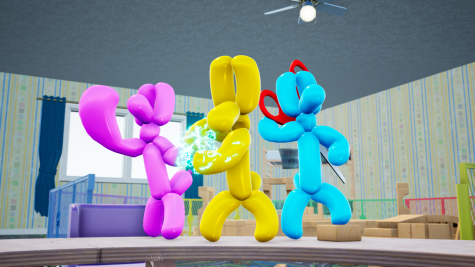
[Name of the Week] Studios
Group Members: Alex Dalton, Producer; Brennan Howell, Artist; Ben Cortijo, Designer; Josh Lanham, Designer; Rosser Martinez, Programmer
Game Name: Pop’d
About the Game: Pop’d channels the look and feel of a PC, third-person shooter and allows players to play as balloon animals in a 3-D arena deathmatch. The characters attack their opponents with sharp objects and static electricity they’ve amassed by moving on carpet.
“The main artistic thing that the players are supposed to take away from it is feedback of playing as a balloon. …We’re trying to bring that in from all angles, not just art, but sort of ensuring the player is able to stretch and inflate and deflate as a balloon is number one priority with the art,” Brennan Howell said.
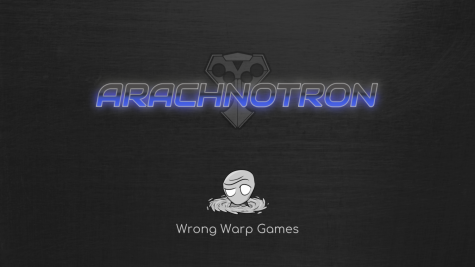
Wrong Warp Games
Group Members: Sean Napolitano, Lead Artist; Evan Janssen, Lead Designer; Nicholas Robbins, Lead Programmer; Nick Oprisu, Lead Producer
Game Name: Arachnotron
About the Game: Arachnotron is a PC, single-player, third-person, over-the-shoulder shooter where the player is a mechanical spider that utilizes a spider’s ability to travel over all surfaces as they fight other mechanical bugs in a quest for revenge. The environments take inspiration from actual insects and nature. For example, one area will be an oil refinery modeled after a beehive.
“From the artistic side, it boils down to the fact that robots are cool and bugs are cool, so robot bugs are even cooler—kind of embracing that ridiculous eighties, like the old Transformers cartoon style and feel of over-the-top ridiculousness for the sake of it looks cool,” Sean Napolitano said.
![]()
Midnight Sprites
Group Members: Amila Nuhodzic, Lead Artist; Joshua Greaves, Lead Designer; Alex Rader, Lead Programmer; Eduardo Fernández, Lead Producer
Game Name: Last Rights
About the Game: Last Rights is a dark fantasy, PC, 2-D isometric, 3on3, action brawler where players take on of the role of mercenary necromancers. They discover the bones of what they believe to be a creator god and fight over whether or not to reanimate them. It’s match-based, so for each match players are assigned to which side of the battle they’re on.
“We thought of doing a new-age magic type thing, kind of like Harry Potter, like Fullmetal Alchemist, something like that. And then, when we came back after the summer, we played with it some more, and we were like, ‘you know, wizards are boring,’ and it became this cyberpunk thing for a little while and we realized that wasn’t really working. Eventually we settled on necromancers,” Josh Greaves said.
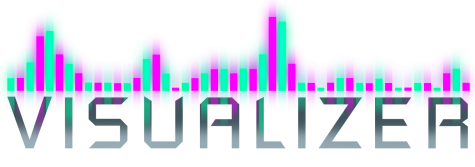
Little Lizard Studio
Group Members: Isaac Singer, Animation Artist; Jen Carlin, Environment Artist; Ryan Place, Designer & Programmer; Simon Estabrook, Designer & Programmer
Game Name: Visualizer
About the Game: Visualizer is a PC, first-person, horde-survival, shooter. The player is an exterminator fighting “sonic ghosts” whose characteristics change depending on the background music. The group is working with a musician to create custom techno-EDM music.
“It’s a rhythm game. It’s based on music and audio,” Jen Carlin said.
“Yeah, it spawned out of a project from last semester where we wanted to test if the player could shoot to a beat, and if that would impede gameplay,” Ryan Place said.
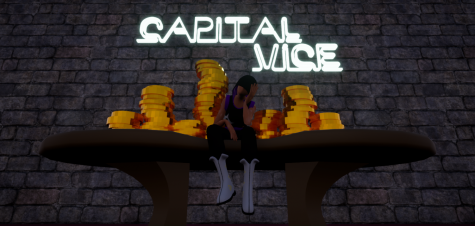
League of Evil
Group Members: Ellie Peak, Artist; Conor Tully, Designer; Dustin Yost, Programmer; Cody Douglas, Producer
Game Name: Capital Vice
About the Game: Capital Vice is a 4-player, king of the hill game where all the players are Vegas acts trying to amass wealth and become famous. There is a gem in the map that allows one player to become Greed, an entity who destroys the environment around them, and collects poker chips to turn in. The other players are trying to destroy the Greed character so they can become Greed. The game takes place in a casino.
“Players have certain tasks they can perform in the game, for the stage acts in our role, the danger act, you can shoot a crossbow, you can throw throwing knives and use a whip to steal coin bags from greed, and you have a firebomb you can throw to stun everyone in the area. Each of these has a certain task you can perform. So for the crossbow, you need to shoot Greed X number of times, and it gives a boost to the ability itself so you can do more damage and be more effective in becoming Greed,” Dustin Yost said.
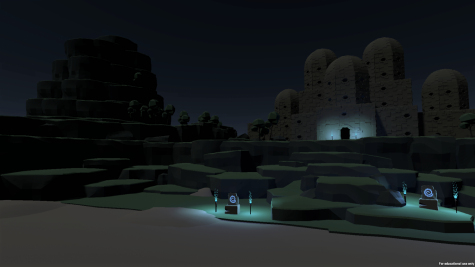
Blazing Heart Games
Group Members: Josh Walker, Artist; Lenny Gingello, Designer; Cory Smith, Programmer
Game Name: Pilgrimage
About the Game: Pilgrimage is single-player, brawler action-adventure hybrid, PC game. It has elements of the combat of 3-D brawlers, but the player moves through the world action-adventure style. The player is a pilgrim visiting an archipelago where each island is devoted to a different god, and the player has to travel between them, stopping malevolent forces coming out of the water. The art utilizes tropical colors, and a “hard normal” art style, which means you can see the polygons or shapes that make up the individual surfaces in the game.
“This was kind of like a mashup: we had this idea of making a game where all the combat was elemental based, and you’d be taking elements from the environment and using them in combat. We merged that with an action-adventure game and this is what came out of it,” Lenny Gingello said.
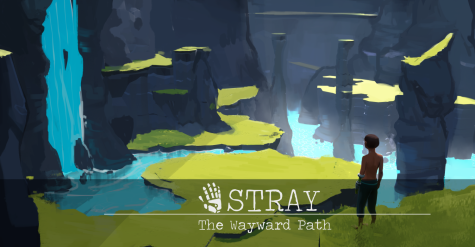
Justice Pork Games
Group Members: Briea Dowse, Environmental Artist; Jocelyn Bedell, Character Artist; Nick Magnus, Co-Lead Designer; Jon Nickerson, Co-Lead Designer; Gabe Troyan, Lead Programmer
Game Name: Stray: The Wayward Path
About the Game: Stray: The Wayward Path is a third-person, single-player, action-adventure, PC game where the player is a young boy who has a mechanical arm with a grappling hook that he uses to transverse environments and fight enemies. The land has become corrupted, the wildlife is aggressive, and the player is fighting through to find their friend and cleanse the environment. The art style is simple, using shape language to give a natural feel.
“Our unique selling point is how the grappling hook is used both in movement mechanics and combat,” Nick Magnus said.

Stay Tuned Games
Group Members: Michael Andrews, Artist; Harry Lindner, Designer; Aaron Hamilton, Programmer; Rory Einiger, Producer
Game Name: 2354
About the Game: 2354 is a first-person, arena-style shooter, multiplayer game that has mechanics tied to rhythm and music. For example, there are “bombs” triggered by sounds that don’t match the beat of the music.
“In terms of the art style, we were going for sci-fi laser light show. Super crazy music festival kind of thing where the player would be able to leave seeing sounds,” Michael Andrews said.

Bullet Mullet
Group Members: Mike Armstrong, Artist; Amanda Gates, Designer; Thomas McGillicuddy, Backend Programmer; David Merritt, Producer; Zachary Taylor, Gameplay/Experience Programmer
Game Name: Tales from Space
About the Game: Tales from Space is a retro-futuristic, twin-stick shooter that follows mercenaries through space competing for guns. It can be played both single-player and cooperatively, and players capture as many guns as possible to fight the corporations that create them. The look of the game is 1950s futuristic, or atom-punk—similar to how The Jetsons looks.
“This was based around a game pitch I had at the beginning of the summer, and a lot of that was based around my desire as a programmer to do a lot of procedural generation, and procedurally generated weapons was a big thing… from there it was like ‘what is a setting where we can have really aesthetically pleasing weapons,’” Thomas McGillicuddy said.
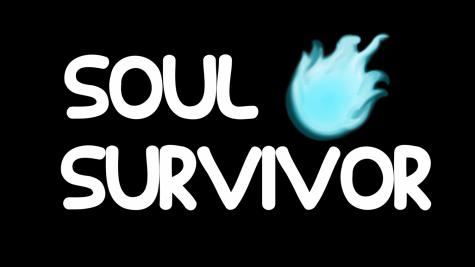
Star Punch Studios
Group Members: Raili Piscusa, Game Artist; Calvin Johns, Designer; JT Woodside, Producer; Lucas Spiker, Programmer.
Game Name: Soul Survivor
About the Game: Soul Survivor is a PC, single-player, roguelike or dungeon-crawler game where the enemies are procedurally generated, so they change every time. The player is the ghost of a necromancer who’s looking for their teacher after being attacked in the hopes that their teacher can bring them back to life. The art is cutesy and cartoonish, inspired by Pokémon Mystery Dungeon.
“Since you’re playing as a ghost, when you kill your enemies, you can collect their soul essence. Using that soul essence allows you to transform into classes or monster variants to play as,” Calvin Johns said.

Fully Cohesive
Group Members: Monica Almodovar, Artist; Dylan Alter, Co-Lead Designer & Programmer; Mico Demo, Co-Lead Designer & Programmer; Gavin Hieronymus, Producer
Game Name: Chroma-Throne
About the Game: Chroma-Throne is a multiplayer, platform fighting game (think Super Smash Bros) where you utilize color in a variety of ways. For example, if the background color matches your character, you can camouflage. The art style is geometric, with lots of solid colors and shapes, and takes inspiration from 1950s Cold War propaganda.
“The idea is that each player in the round is a champion of their color kingdom, so there’s the blue kingdom, the red kingdom, etc. The reason you’re all fighting is for that kingdom’s dominance over the others,” Dylan Alter said.
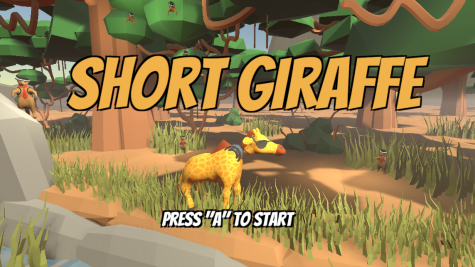
Cup O’ Joe Studios
Group Members: Dylan Gooley, Artist; Joe Martellucci, Game Designer; Christine Brumbaugh, Designer/Producer; Matt Roy, Programmer
Game Name: Short Giraffe
About the Game: Short Giraffe is single-player, PC game featuring a cyborg giraffe with a mechanical neck. The player navigates through levels by extending the giraffe’s neck to solve puzzles.
“The real inspiration is that we were going through spitballing ideas, and we didn’t really think of anything. My boyfriend sent me a picture earlier in the week that was of a short giraffe, so I threw that out there, and it somehow stuck around, and we turned it into an actual game,” Christine Brumbaugh said.
Glossary:
- Point and Click: A genre of games where the narrative is navigated through the player moving a mouse (or controller) around a screen and clicking on items or characters to engage in dialogue or gather clues. Since Blood and Ink is a tablet game, the team calls it a “tap and pinch” which is the touch screen equivalent.
- Puzzle Platformer: A genre of games where the player solves puzzles (like channelling an electric current or moving obstacles) to navigate through a level map consisting of suspended platforms.
- 2v2 or 3on3—A style of multiplayer games where players are grouped into teams that compete with each other.
- Third-person Shooter: A 3-D game where the primary gameplay consists of shooting, and the player can see their character on-screen the entire time.
- Arena Deathmatch: A free-for-all game where the goal is to kill as many other players as possible within a set environment/arena.
- Isometric: An art style that has the camera angle positioned in a way that displays facets of objects so they look 3-D. The Wikipedia page has nice reference images.
- Action Brawler: A game involving hand-to-hand combat or close range combat, typically with multiple opponents at once.
- First-person Shooter: A genre of games where the primary gameplay consists of shooting a gun or other weapon, and the viewpoint is through the eyes of the player’s character.
- Horde Survival: A game where the player has to survive the attacks of waves of enemies, which increase in number and difficulty level over time.
- King of the Hill: A game in which one character is “king” and owns a resource or controls a stronghold or territory, and the other players attempt to defeat the “king” and take their place.
- Roguelike: A genre of games where the player navigates through dungeons (not necessarily literal dungeons, but rather complex maps with many rooms to work through), composed of procedurally generated content, so gameplay changes every iteration. Additionally, roguelikes include permanent death.
- Procedural Generation: Sometimes called random generation, procedural generation defines a set of parameters and then lets code determine the outcome as opposed to the programmer or designer doing it manually. For example, in roguelikes, a room will have a set amount of monsters, but the type of monsters and kind of loot in the room will be procedurally generated. The game creator decides what the available options are, but an algorithm determines the outcome. For Tales from Space, this system takes the various weapon components and randomly combines them to create unique weapons.
- Twin-stick Shooter: A shooter game where the controls consist of 1 joystick/set of controls that manages the character’s movements, and another set that manages where the character’s weapon is aiming.
- Mech: A giant robot or machine that can be controlled by people. They are typically humanoid or can walk on two legs, but they do not have to be.
Disclaimer: While The Crossover made every effort to communicate with all groups, and check-in to update this article right up until publication, not all groups were responsive. There may be some groups who are not included in this article, or groups who have changed aspects of their games since they last met with The Crossover.





